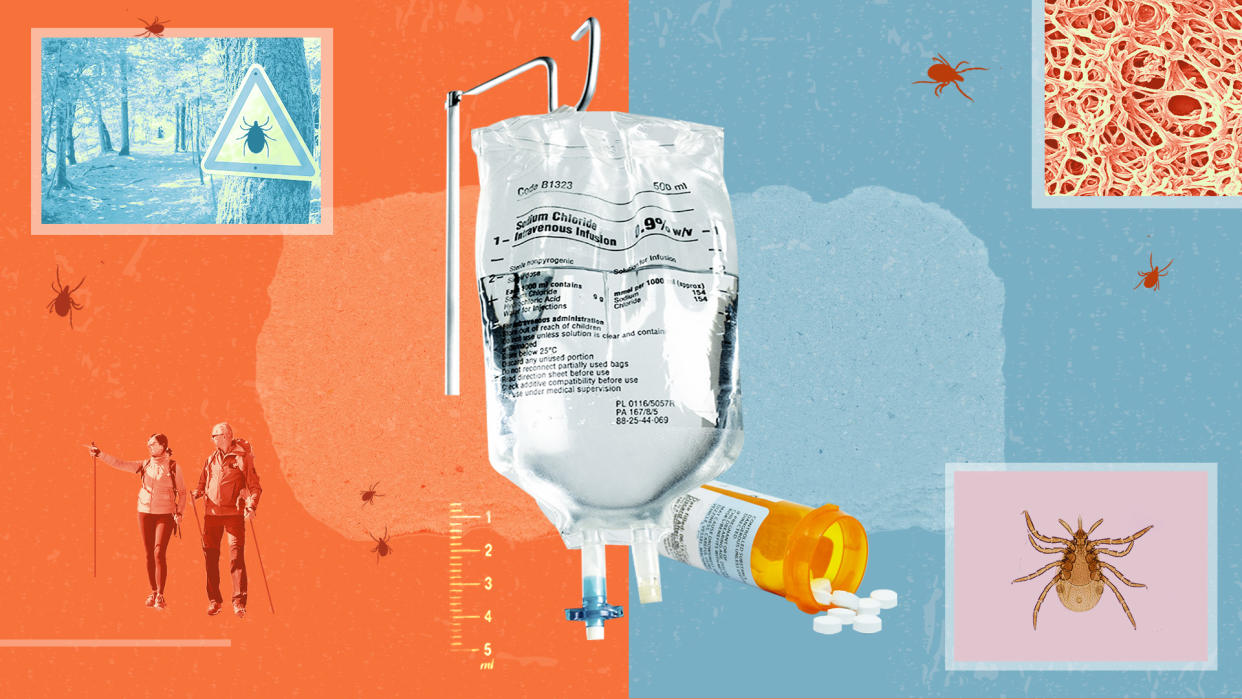Bella Hadid and Riley Keough undergo intensive treatments for Lyme disease. The average person can spend up to $10,000 a week treating the condition.

In a Vanity Fair interview earlier this month, Daisy Jones & the Six star Riley Keough revealed something she had never spoken about with the press before: her battle with chronic Lyme disease.
She shared that she went to Switzerland between acting projects in order to pursue treatment, explaining, “I used this little break that I have to come and try and see if I can alleviate it a bit. It’s a holistic treatment center and offers all kinds of things that you can’t really do in America yet, like cleaning your blood.”
Keough is not the only celebrity to mention that they are going to extreme measures to try to treat Lyme disease. Bella Hadid recently shared an Instagram post in which she said she had just completed more than 100 days of treatment for her chronic Lyme, following “almost 15 years of invisible suffering.” The model included photos of herself — in one, she had an IV in her arm, and in another, she was getting blood drawn.
Stars can go through extensive treatments in order to find relief for chronic Lyme disease, but for the average person, treatments may be out of reach. Here’s what to know.
What is Lyme disease?
“Lyme disease is an infection caused by the Borrelia burgdorferi bacteria, which is in the same family as syphilis — a particular type of bacteria,” Dr. Christopher Bazzoli tells Yahoo Life.
Lyme disease is generally contracted after being bitten by a certain type of tick called a blacklegged Ixodes, also known as a deer tick.
In order for Lyme to be transmitted, the tick must attach to a person for a sufficiently long time, about 36 to 48 hours. While that may seem like a long time, the ticks are roughly the size of a sesame seed and are often not discovered.
A person infected with Lyme will often display signs and symptoms such as a target-lesion rash, fevers, chills and body aches. However, these symptoms might not be associated with a tick bite at all, especially if the person is missing the unique target rash, which can be a giveaway symptom but does not appear on everyone.
There is also some evidence to suggest that Lyme disease may be sexually transmitted, though more research is needed. It is also possible (though rare) to pass Lyme disease in utero if a pregnant person is infected. Bella Hadid’s mother, Yolanda Hadid, has chronic Lyme disease, as does her younger brother, Anwar.

How is Lyme diagnosed?
According to the Centers for Disease Control and Prevention, there is a two-step approach to testing for Lyme, which can be done with the same blood sample. Yet not everyone who has Lyme disease will receive a positive test result. Most Lyme disease tests are designed to detect antibodies made by the body in response to infection. Since these antibodies can take weeks to develop, individuals may test negative if infected only recently.
Once antibodies are made, they can linger in the body for years, so it’s also not possible to tell whether someone is “cured” of Lyme by their presence.
How is Lyme disease treated?
“Treatment ... is a course of antibiotics that is very inexpensive, typically doxycycline,” says Bazzoli of primary steps.
Yet not everyone treats Lyme disease right away because not everyone knows they even have Lyme disease in the first place. This means that the disease can progress, unbeknownst to someone, in the body. People like the Hadids say their symptoms of Lyme disease are wide-ranging and include chronic fatigue, fevers, muscle and joint pain and skin rashes.
However, the idea that Lyme disease can linger in one’s body for years, especially after initial treatments with antibiotics, is not completely recognized.
What is chronic Lyme disease?
People who struggle with Lyme disease symptoms well after their initial infection call this condition “chronic Lyme disease (CLD),” though that term has been met with controversy. The National Institute of Allergy and Infectious Diseases (NIAID) says that “CLD” has been used to describe illness in patients with Lyme disease in addition to “symptoms in people who have no clinical or diagnostic evidence of a current or past infection. ... Because of the confusion in how the term CLD is employed, and the lack of a clearly defined clinical definition, many experts in this field do not support its use.”
The CDC says, “Some patients report persistent symptoms of pain, fatigue or difficulty thinking even after treatment for Lyme disease. The state of the science relating to persistent symptoms associated with Lyme disease is limited, emerging and unsettled. Additional research is needed to better understand how to treat, manage, and support people with persistent symptoms associated with Lyme disease.”
Because of these “research gaps,” the CDC says it does not provide guidance for “treatment of persistent symptoms in people previously treated for Lyme disease.”
Singer Avril Lavigne, who has been open about her battle with Lyme disease, told Good Morning America in 2015, “I was in Los Angeles, literally, like the worst time in my life and I was seeing, like, every specialist and literally, the top doctors, and they were so stupid, and they would pull up their computer and be like, ‘chronic fatigue syndrome,’ or ‘Why don’t you try to get out of bed Avril, and just play the piano? Are you depressed?’ This is what they do to a lot of people who have Lyme disease. They don’t have an answer for them so they tell them, like, ‘You’re crazy.’”
Yet there are doctors who take the potential of chronic Lyme disease seriously.
Functional medicine doctor Mac Toohey tells Yahoo Life, “The initial two-to-four-week antibiotic treatment for Lyme disease is usually covered by health insurance providers. Unfortunately, because chronic Lyme disease is not officially recognized by the CDC, some medications and most IV treatments for treating Lyme and its co-infections are considered ‘experimental’ and therefore have no guarantee to be covered by insurers. Most Lyme practices ask patients to submit what’s called a ‘superbill’ to their insurance companies to reimburse them for the cost of the visit, IV services and specialized testing.”
What treatment options are available to people who believe they have chronic Lyme?
“Usually with Lyme disease, you get it from a tick, and you get a family history of different diseases that the tick had,” Toohey explains. “It makes treatment really difficult, because each patient’s symptoms and clinical picture and what organ is affected is completely different. It makes it hard to have an algorithm for how to treat a patient, and it’s why it can take six months up to 10 years to actually start feeling better from Lyme disease, because you’re trying to treat all these issues.”
Toohey says the conventional way of treating Lyme disease involves “antibiotics, antiviral and antiparasitics.” This could include a mix of IVs and oral medications, with IVs being much more of an expense typically than oral medications. IVs can also be used to support the immune system.
One inexpensive treatment that functional medicine doctors like Toohey use is herbs, such as Scutellaria baicalensis (Chinese skullcap), Cryptolepis sanguinolenta, Polygonum cuspidatum (Japanese knotweed), Uncaria tomentosa (cat’s claw), Artemisia annua (sweet wormwood), Sida acuta (common wireweed) and Houttuynia cordata (chameleon plant).
Another experimental treatment involves bee venom, such as the ones made available by the Heal Hive, a company that seeks to treat chronic inflammatory diseases holistically.
While most doctors who are “Lyme literate” do not accept insurance — because treatments are considered experimental — there are some ways to save money should you seek out their care.
“We encourage patients to use coupon services (e.g., GoodRx, America’s Pharmacy, ScriptSave WellRx) and patient foundation grants (e.g., LymeLight Foundation for patients 25 and younger or Lyme Treatment Foundation for patients of all ages) to cover prescription medication expenses,” Toohey says.
Toohey advises patients seeking help for chronic Lyme to “work with somebody that will give you all of your options, and somebody who understands that medical debt is a real thing and how to help.”
“Some patients can spend up to $10,000 a week, depending on what kind of treatments they’re getting,” she says, “and that’s not realistic for anybody.”
